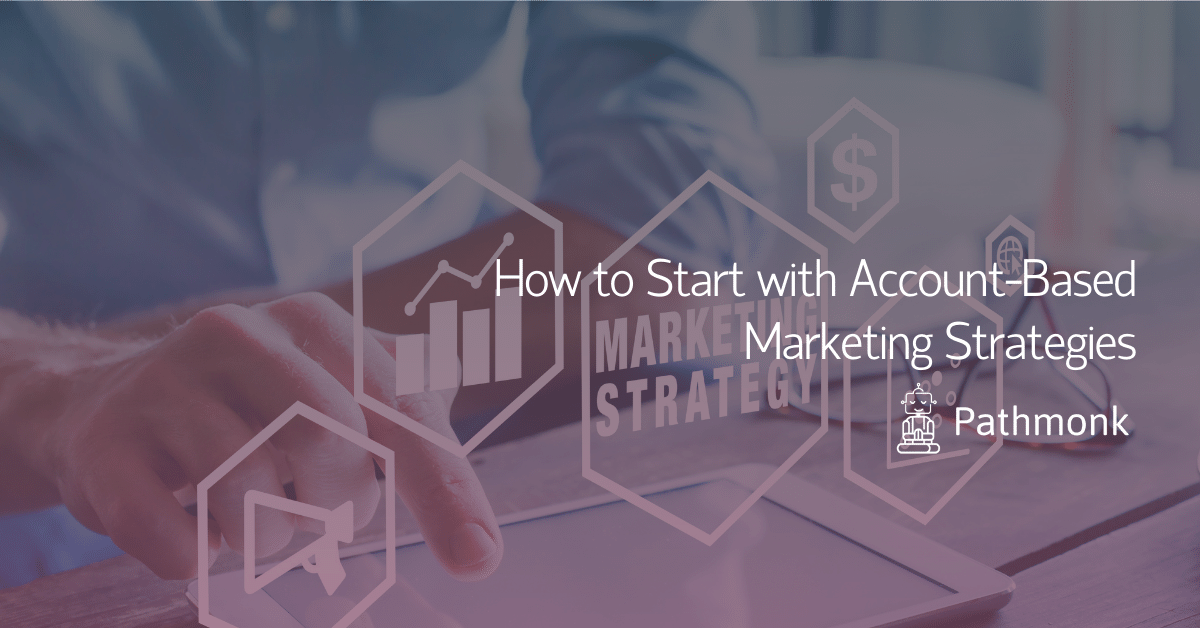
Thousands of marketers express interest in implementing account-based marketing tactics. Having heard about its effectiveness and success, many business owners are eager to make the changes to encourage further growth.
Read on and find out everything you need to know about account-based marketing, how to start using it, and much more.
Generate better leads to grow your sales
Discover new strategies to unlocking a flood of high-quality leads from your website.

What Is Account-based Marketing?
Most marketers understand that personalized campaigns work better than generalized and broadly-targeted campaigns. Yet, many have been guilty of advertising their websites or product to a broad audience, hoping to blindly gain potential prospects.
One way of successfully customizing an audience’s experience is with Account-Based Marketing tactics.
An account-based marketing strategy consists of attracting customers that are the right fit for your products. Thus, instead of running general campaigns with small customizable features, you can focus on specific traits of those clients that have the potential to remain loyal to your brand.
Account-based marketing takes the regular marketing model and turns it upside down. Instead of focusing on attracting people, nurturing relationships, and then closing deals, it identifies the best customers, engages with them, and expands the business.
What Are the Most Important Benefits of ABM Tactics?
Each time you start considering a new marketing strategy, you should evaluate the benefits it offers and determine if it’s the right decision for your company.
Many marketers have highlighted specific benefits that ABM tactics offer. Take a look at the ones that stand out.
1. Your Sales and Marketing Team Align
Aligning your sales and marketing team is an incredible advantage of using account-based marketing tactics.
Nonetheless, many marketers don’t know what aligning means, so they don’t understand how it can help their business. In simple terms, aligning refers to making sure your sales and marketing teams have the same philosophical approach and practical strategies to handle clients.
When your teams align, they work together to achieve a common goal. Therefore, when a new lead appears, both groups are chasing it instead of following unqualified leads that don’t give you any revenue.
2. You Have a High Return of Investment
One of the most important things to do when you run a business is to track your return of investment or ROI.
If you spend your hard-earned money making your company grow, you’ll want to see a high return on investment, ensuring you’ve dedicated funds to the best opportunities.
Relying on an account-based marketing strategy helps you focus on what’s important. With the opportunity to focus on and engage with a B2B buyer you can ensure that they go from a prospect to conversion.
Therefore, account-based marketing helps you to guarantee that each dollar spent will attract the right prospect, so you get a high ROI later.
3. Increased Revenue
Any marketing initiative should have the final goal of increased revenue. However, the best ones ensure that you get more than you might expect.
Researchers have studied companies that use ABM strategies, and they’ve found that they make more revenue than the ones that don’t. Therefore, account-based marketing is an obvious solution to increased revenue.
Logically, when your teams are aligned towards a common goal, they can focus on achieving it. Consequently, you get better chances of closing good deals and gaining more revenue.
To make this an even more efficient process you can leverage professional teams. With Pathmonk, you can get Artificial Intelligence at your disposal to help you convert more people.
How to Start Using an Account-based Marketing Strategy
Increasing your revenue and expanding your business is no small feat, even more so if you want to use ABM tactics. It requires effort and time in order to achieve a fully successful strategy.
Although account-based marketing seems like an obvious decision for your business, 30% of marketers do not implement it successfully. We believe more businesses would consider it with the right guide. Take a look at the following steps to start building your ABM strategy.
1.Make a List of Target Accounts
If you want to use account-based marketing correctly, you have to focus your strategies on specific accounts. Therefore, the first step includes research.
To start the list, use the customer data you already have. Try to locate companies that match your target client.
You don’t need to locate an extensive list. The process still requires further steps, so don’t worry if you don’t initially have many options.
Once you’ve located those core clients, you can leverage LinkedIn to gain more insight into these persona profiles. From here LinkedIn can suggest similar profiles and accounts to add to your list.
2. Find out More about Each Account
Using account-based marketing requires much research if you want to implement it correctly. However, you need to know what you should pay attention to.
As a part of your research, you should understand the industry’s details, competitors, who manages it, how the roles are distributed, and what’s the organizational structure, etc.
Fortunately, all that information is usually found on the company website. When you’re in the research phase, you should focus on understanding the company’s decision-makers.
Focusing on research is the key to building a good ABM strategy. If you successfully identify the decision-makers, you can pass that information to sales, to begin a successful campaign.
3. Create Innovative and Relevant Content
B2B users of today expect much more from their online experience. It is, therefore essential that you are innovative and provide a unique experience.
Giving people personal and relevant content allows you to become a brand and website that they can trust and turn to in order to solve issues. For example; Pathmonk provides clients with a useful AI to increase conversion rates and its reliable software has created loyal and returning customers.
However, on Pathmonk’s website, you can also find useful resources to help you understand varying marketing and sales concepts. When you create the content for your company, you could organize it depending on where the buyer is in the funnel. There are many options: posts, e-books, and case studies are just a few you could experiment with.
4. Distribute Your Content to the Right Audience
The main goal of using account-based marketing is to make sure your content reaches the right people. Thus, content distribution is probably the most critical step in the process.
When you have the right people to reach out to, and you create engaging content, you can nurture good relationships with your customers. The best way to distribute the content is to use emails.
Using emails sounds old-fashioned, but it’s one of the most effective ways to ensure that campaigns reach the right people. You can decide who gets which email, when and how they receive it.
5. Monitor the Results
Every strategy you implement in your business needs monitoring. Each time you try something different, you need to evaluate whether it worked or not.
The goal of account-based marketing is to foster effective relationships with the right customers. Keep in mind that it can take months or even years to achieve that. Therefore, don’t get discouraged if you don’t see much progress at first.
Some Account-Based Marketing Examples
Now we’ve equipped you with the basics to understanding account-based marketing, here are some examples. They might spark your creativity and motivation and drive you to start making changes in your own company.
A great example of well-used account-based marketing is a company that uses direct mail to reach out to some of its clients.
The company sent a package that contained a handwritten note, a printed customer review, and a sticker. The essential aspect of their strategy is the note – they created a personal connection with the prospect.
Some packages contained a copy of an eBook. It depended completely on the prospect they targeted. With the aforementioned example, you might see the importance of creating a personal connection to ensure a stable relationship with your prospects.
In the mentioned example, 29% of people responded and the company had a positive conversion rate. The strategy is also a good reminder to make your campaigns fun – align them with your goals, but don’t forget to enjoy the process as well.
Conclusion
Implementing account-based marketing tactics is an impactful growth strategy for any business. However, it takes time and effort to nurture healthy relationships with accounts.
Now that you know all the basics, you can start implementing new strategies in your company. Remember to do your research and always enjoy your process.
Understand your customer journey analytics
See how your users behave, find drop-offs, and receive actionable insights with AI.









